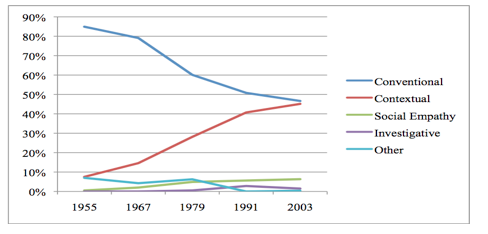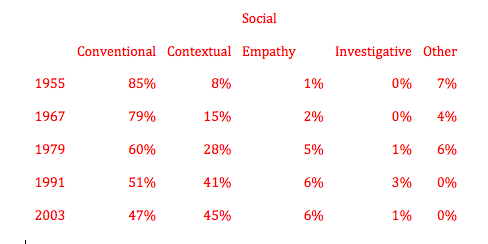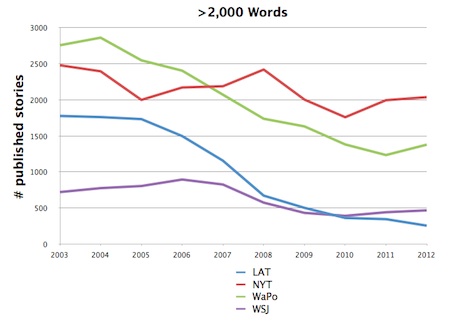Katherine Fink and Michael Schudson have a fantastic new paper called “The Rise of Contextual Journalism, 1950s-2003,” to be published this summer in the British* scholarly journal, Journalism.
It defines—and documents—the rise of a form of reporting that is deeper, more independent, less deferential to government, than conventional, run-of-the-mill news stories. The paper is sort of a high-end prequel to the informal post I did in January, “Major Papers’ Longform Meltdown,” on the stunning decline in longform newspaper writing at four major papers, since 2003.
Fink and Schudson here are—in a way—documenting the rise before the fall. The difference is I was just measuring raw story length (word count>2000, for instance) and looked at a slightly different set of papers. I just saw it as another data point, and I had no idea they were working on their paper. Theirs is a full content analysis that seeks to make qualitative distinctions between different types of stories (see their criteria on page 18). They don’t equate length and quality, of course, but they do draw a connection between the two.
Fink is a Columbia Journalism Phd candidate. Schudson, a former suitemate at Columbia (CJR moved to midtown last fall), is one the country’s top journalism scholars, and this paper is a pretty good example of why. His work down through the years, like his 1995 classic, The Power of News, is certainly scholarly and empirically based. But in a conversational tone, it also brings both a commonsense approach to the news—a realistic understanding of the possible—and an equally clear understanding of its importance in a reasonably well-functioning society.
Think about it this way: Everyone understands the limitations of the MSM, both now and certainly, too, in recent decades, aka, “back in the day,” sometimes referred to as the Golden Age. You can pick from among these critiques—timid/biased, sycophantic/reckless, shallow/boring, trivial/self-important, sloppy, unethical, practitioners exhibit poor nutritional habits, etc. etc.—or fill in your own in comments.
But if you think MSM is and was bad, the question then becomes, compared to what? And if you think it’s been bad lately, it was, by common consensus, just hopeless in the 1950s: Coziness between reporters and sources, deference to whoever was in power, private lives always off limits—basically, journalism as stenography, briefing attendance, and press-releases rewriting. A 1999 study by Carl Sessions Stepp comparing newspapers of the early ’60 and late 90s concluded the earlier era’s papers come across as “naively trusting of government, shamelessly boosterish, unembarrassedly hokey and obliging.” As Fink and Schudson put it: “Essentially no one defends the journalism of the 1950s.”
But in the 1960s, the news business, following society, underwent a shift. It started to produce stories that didn’t necessarily originate from an institution or official, use the pyramid style, or include the word “yesterday,” and did contain an essential element: context. Fink and Schduson give the new form the wonky term, contextual journalism, but add that it’s gone by other names: interpretative reporting, depth reporting, long-form journalism, explanatory reporting, analytical reporting, or “social science journalism,” defined in a 1981 study as reporting intended to focus less on events than causes.
Fink and Schudson summarize the academic literature on changes in mainstream journalism since the 1960s and conclude:
The news has grown more critical of established power; journalists have come to present themselves publicly as more aggressive; news stories have grown longer (and presumably deeper); news stories have grown less government-and-electoral-politics-centered; and news has grown more contextual.
And the ability to go longer almost certainly has something to do with newspapers getting better. The authors point to a 1997 study by Kevin Barnhurst and Diana Mutz documenting the rise of longer stories and Stepp’s 1999 study:
Barnhurst and Mutz do not certify that the longer stories of 1974 and 1994 offer “better” journalism than the shorter stories of 1954 and earlier, but it is hard not to believe that, in general, this is so. Stepp acknowledges that the 1999 papers struck him as “less flavorful, less surprising, and – distressingly – less imbued with a distinctive sense of place” than those of 1964. Nevertheless, he judges that the 1999 papers were “by almost any measure, far superior to their 1960s counterparts.” They were “better written, better looking, better organized, more responsible, less sensational, less sexist and racist, and more informative and public-spirited.”
And of all the forms, it’s contextual journalism that, almost unnoticed, exploded, mostly at the expense of the conventional style.
Although this category is, in quantitative terms, easily the most important change in reporting in the past half century, it is a form of journalism with no settled name and no hallowed, or even standardized, place in journalism’s understanding of its own recent past.
Fink and Schudson define it this way:
Contextual stories tend to focus on the big picture, providing context for other news. If the conventional story is a well-cropped, tightly focused shot, the contextual story uses a wide-angle lens. It is often explanatory in nature, sometimes appearing beside conventional stories to complement the dry, just-the-facts versions of that day’s events.
Got it. Fink and Schudson carry this forward, studying three papers, The New York Times, The Washington Post, and the Milwaukee Journal-Sentinel (considered representative of good regional daily), over selected periods in 1955, 1967, 1979, 1991 and 2003, dividing page one stories into five categories: conventional, investigative, social empathy, contextual, or other. The names mostly speak for themselves, but one thing to keep in mind about conventional stories is that they usually, “often, though not always, inform the public about the official activities of government.” Not that there’s anything wrong with that, but the idea is that official institutions set the agenda, the press follows.
The relevant chart and table are here:


One way to think about it is:
The notion that the news media are dominated today by “he-said-she-said” stories that write themselves is not a valid general critique of leading U.S. newspapers, nor has it been for several decades.
Fink and Schudson acknowledge that contextual journalism’s “impact on how people understand their world is yet to be explored.” That is to say, it’s hard to know what good it all did. But then, you can say that about any form of cultural product. Good work is its own justification.
The authors offer various reasons for this sea change and point mostly to a “normative” shift in the profession. That is, people just decided to do things differently. I’d probably have added a word about the newspapers’ consolidation into quasi-monopolies and the post-war boom in their ad revenues, which provided the economic underpinning to all this context.
Now I’m curious to see what the chart would look like if carried forward from the year 2003, after the economic foundation began to collapse, to see if the lines would look anything like mine:

*The journal is published by Sage Publications, which has offices in Thousand Oaks, California, London, and elsewhere.
Dean Starkman Dean Starkman runs The Audit, CJR’s business section, and is the author of The Watchdog That Didn’t Bark: The Financial Crisis and the Disappearance of Investigative Journalism (Columbia University Press, January 2014). Follow Dean on Twitter: @deanstarkman.
